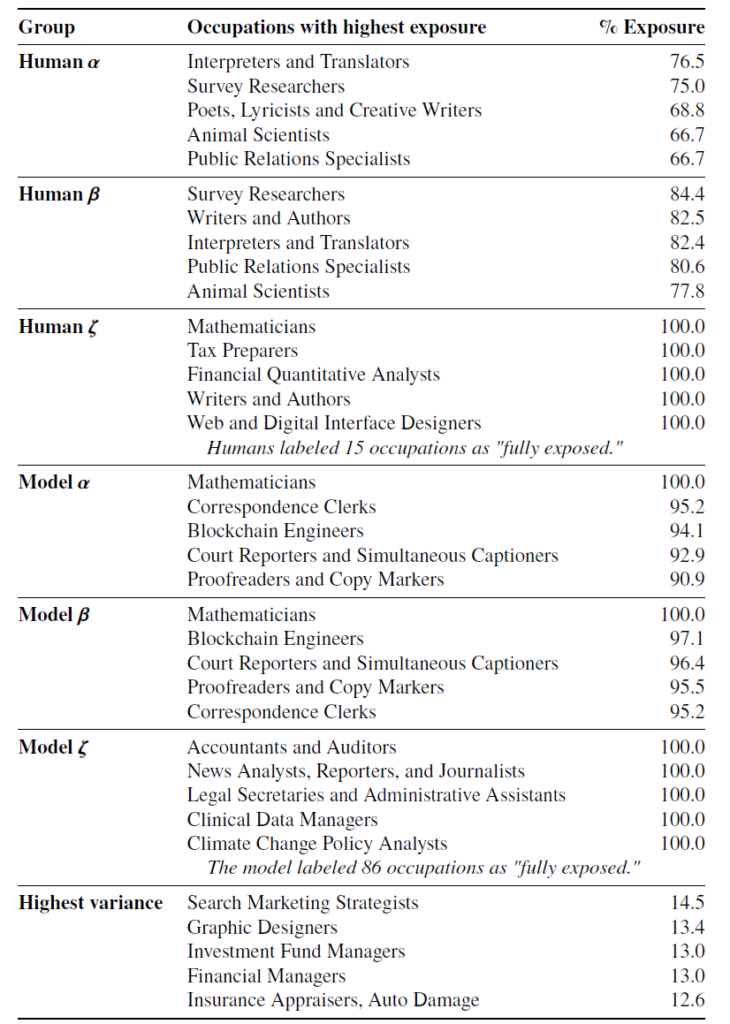
Here are a few quick takes on a recent paper from OpenAI entitled “GPTs are GPTs: An Early Look at the Labor Market Impact Potential of Large Language Models”.
Besides the acronym GPT for Generative Pre-Trained Transformer, this paper also refers separately to GPTs as “General-purpose technologies” such as the Steam Engine or Printing Press
Author-enhanced GPT4 summary = “Generative Pre-trained Transformers (GPTs) generate profound transformations, garnering potential technological growth, permeating tasks, gutting professional management. Gauging possible trajectories? Generate pioneering taxonomies, gather policymakers together, generalize past today.”
Page 23 – 7.2 GPT Conclusion (Author-Augmented Version)
Three Key Takeaways from the paper:
- LLMs will influence 49% of occupations by affecting half of their tasks – As AI progresses, it will increasingly automate and impact various aspects of your professional life. Jobs that are more white-collar will experience a more significant disruption.
- LLMs will impact 10% of tasks in 80% of occupations – In the short term, the majority of individuals will experience AI affecting only a minimal part of their daily work.
- The more challenging it is to enter a field, the more susceptible it is to LLMs – Fields like creative work and software engineering demand a certain level of understanding and effort to succeed, and AI is rapidly mimicking these abilities.
Notable quotes (emphasis mine):
“Concurrently, researchers have improved the steerability, reliability, and utility of these models using methods like fine-tuning and reinforcement learning with human feedback (Ouyang et al., 2022; Bai et al., 2022). These advancements enhance the models’ ability to discern user intent, rendering them more user-friendly and practical. Moreover, recent studies reveal the potential of LLMs to program and control other digital tools, such as APIs, search engines, and even other generative AI systems (Schick et al., 2023; Mialon et al., 2023; Chase, 2022). This enables seamless integration of individual components for better utility, performance, and generalization. In the long run, these trends suggest that LLMs may be capable of executing any task typically performed at a computer.”
Page 4 – 2.1 The Advancement of Large Language Models
“For the most part, generative AI models have predominantly been deployed as modular specialists, carrying out specific tasks, like generating images from captions or transcribing text from speech. However, we argue that it is essential to adopt a broader perspective, recognizing LLMs as crucial building blocks for additional tools. While constructing these tools and integrating them into comprehensive systems will take time and necessitate significant reconfiguration of existing processes across the economy, we already observe emerging adoption trends. Despite their limitations, LLMs are becoming increasingly integrated into specialized applications in areas such as writing assistance, coding, and legal research, paving the way for businesses and individuals to adopt GPTs more widely.”
Page 4 – 2.1 The Advancement of Large Language Models
“We emphasize the significance of these complementary technologies, partly because out-of-the-box general-purpose GPTs may continue to be unreliable for various tasks due to issues such as factual inaccuracies, inherent biases, privacy concerns, and disinformation risks (Abid et al., 2021; Schramowski et al., 2022; Goldstein et al., 2023; OpenAI, 2023a). However, specialized workflows—including tooling, software, or human-in-the-loop systems—can help address these shortcomings by incorporating domain-specific expertise.”
Page 4 – 2.1 The Advancement of Large Language Models
“Our findings suggest that, based on their task-level capabilities, GPTs have the potential to significantly affect a diverse range of occupations within the U.S. economy, demonstrating a key attribute of general-purpose technologies.”
Page 11 – 4 Results
“(table below)…As such, occupations listed in this table are those where we estimate that GPTs and GPT-powered software are able to save workers a significant amount of time completing a large share of their tasks, but it does not necessarily suggest that their tasks can be fully automated by these technologies.”
Page 15 – Table 4

“Moreover, the adoption of LLMs will vary across different economic sectors due to factors such as data availability, regulatory quality, innovation culture, and the distribution of power and interests. Consequently, a comprehensive understanding of the adoption and of large language models by workers and firms requires a more in-depth exploration of these intricacies.”
Page 21 – 6.1 GPTs as a General-Purpose Technology
As generative AI advances swiftly and attracts significant investments, challenges loom on the horizon for organizations, institutions, and businesses dealing with the repercussions across global workforces. Established organizations with extensive governance, technical, security, regulatory, and other pertinent business documentation appear poised to capitalize on innovative findings derived from Large Language Models’ ability to synthesize seemingly unrelated information. Likewise, organizations with well-documented automated business processes may be able to efficiently integrate the latest capabilities offered by Large Language Models such as GPT-4.

